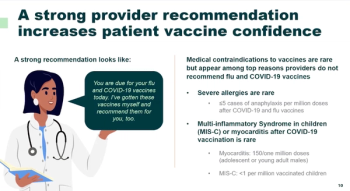
Early activity indicates this year’s flu vaccine may be a good match
It’s too early yet to say whether last year’s devastating flu season will motivate more patients to receive flu shots, but so far it looks like a good year for the vaccine.
While the 2018-19 flu season is off to a slow start, public health officials believe activity will increase in the coming weeks, especially with holiday travel on the horizon.
“It looks like the flu season is fast-approaching,” said Mary Anne Jackson, MD, FAAP, professor and interim dean at the University of Missouri Kansas City School of Medicine. “A couple of states are reporting more than sporadic activity, and that usually means in will ramp up.”
Although there is a lot of time left in this flu season-the flu season usually peaks between December and February-Jacksonsaid early activity is providing a glimpse at how the rest of the winter might unfold.
“A couple of interesting items we’ve noticed is that it appears H1N1 strains are predominating and we are also seeing some influenza B Yamagata, which is unusual as influenza B tends to be a later season event,” Jackson said. “There does appear to be a match at least at this point with the current predominant circulating strains and the strains in vaccine.”
As of Nov. 9, the Centers for Disease Control and Prevention (CDC) was reporting moderate flu activity in Georgia, Louisiana and Oklahoma, and low or minimal activity across the remainder of the country.
Influenza A (H1N1), influenza A (H3N2), and influenza B viruses are all circulating, with influenza A (H1N1) being the predominant strain so far. According to the CDC, influenza A (H1N1) has shown up in 78.3 percent of samples tested since late September, 21.7 percent were influenza A (H3N2), and 13.1 percent were influenza B viruses.
This year’s influenza vaccine includes an A/Michigan/45/2015 (H1N1)pdm09–like virus, an A/Singapore/INFIMH-16-0019/2016 (H3N2)-like virus, and a B/Colorado/06/2017–like virus (Victoria lineage). Quadrivalent influenza vaccines include these three viruses plus a B/Phuket/3073/2013–like virus (Yamagata lineage).
Vaccine manufacturers have estimated a total supply of 163 million to 168 million doses of the flu vaccine for this season, and as of Nov. 9, the CDC is reporting about 159 million doses have already been administered.
According to the CDC, coverage with the flu vaccine among adults was 37.1 percent during the 2017-18 flu season compared to 43.3 percent the prior year. Coverage was lower in every age group last year-the lowest level in seven flu seasons, but vaccination increased with age from 26.9 percent among adults aged 18 to 49 to 59.6 percent among adults aged 65 and up.
Still, it was a dangerous year for the flu-about 48.8 million people were infected with the flu, resulting in 959,000 hospitalizations and 79,400 deaths.
Last season, about 78 percent of vaccinations were administered by November-right around the time flu cases begin to rise. Coverage in the 2017-18 vaccine focused on influenza A (H1N1) with 65 percent coverage, but influenza A (H3N2)-with just 25 percent coverage in the vaccine-was the predominant strain, so the vaccine was about 40 percent effective overall, according to the CDC.
Newsletter
Stay informed and empowered with Medical Economics enewsletter, delivering expert insights, financial strategies, practice management tips and technology trends — tailored for today’s physicians.




